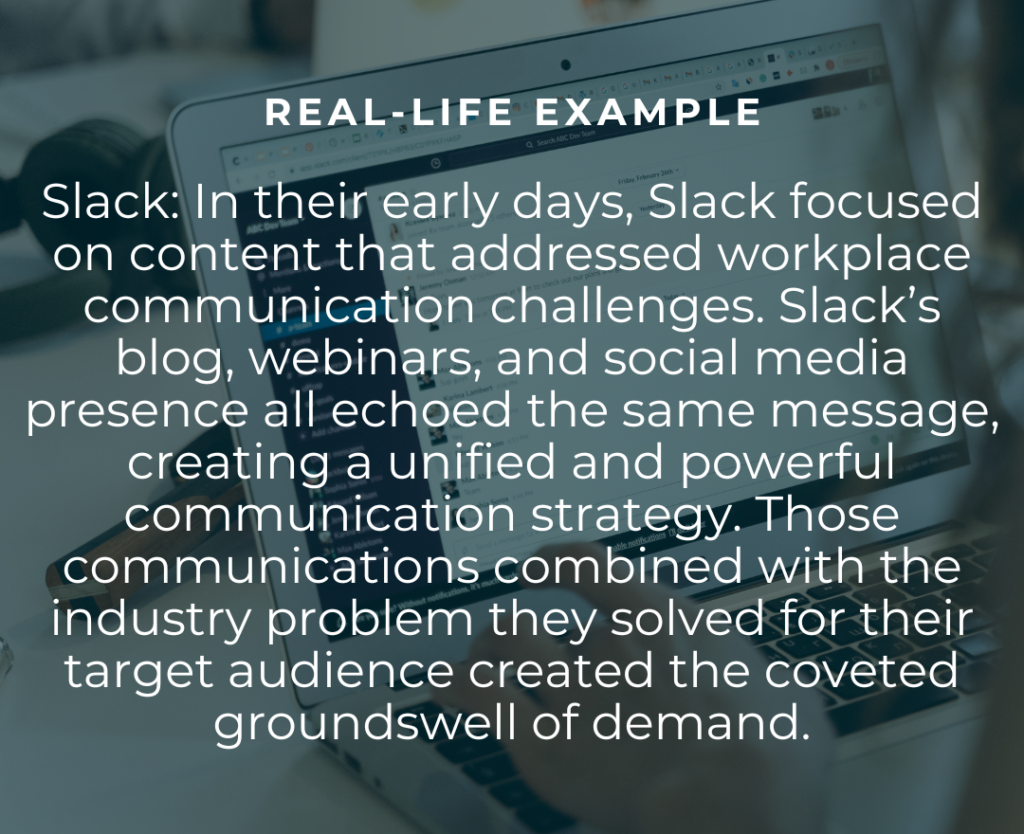Table of Contents
ToggleWelcome to the world of startup marketing, where every move is a strategic play and every campaign must resonate with your audience. Mastering the art of demand generation is not just a choice, but a necessity for carving your startup’s path to success. So, what exactly is demand generation, why does it matter, and how can you excel in it? In this post, we’ll cover those answers as well as the five critical steps to a successful demand generation strategy and tips to navigate the most common challenges facing marketers today.
Let’s dig in.
What is Demand Generation?
B2B marketing often uses demand generation interchangeably with other terms like lead generation, paid advertising and more. This is often not a fair characterization. Demand generation at its core is about building relationships with your audience and creating a groundswell of demand without explicitly selling to your audience. That approach may include paid media or lead generation.
“Demand generation allows you to share relevant value propositions and help the audience understand how your organization, product, or service can solve their challenge.”
Why is Demand Generation Crucial to Success?
In the startup landscape, where resources are scarce, demand generation becomes the catalyst for growth. It ensures that your target audience not only knows about your offering, but is compelled to engage with it.
Demand generation allows you to reach beyond your existing audience. It allows you to create new relationships with users who don’t already know your brand by being a part of crucial conversations. This increases your share-of-voice and builds a groundswell of interest that you can capitalize on in later stages of the customer journey.
Implementing Effective Demand Generation
Now that we’ve established the importance of demand generation, let’s roll up our sleeves and delve into how you can implement it effectively for your startup.
Step 1: Understand Your Customer’s Journey
Defining the customer journey is a crucial first step in implementing effective demand generation. From unknown to closed won revenue, map the steps that someone in your ideal audience would go through like:
- How does their thinking shift at each stage?
- What do they need to know or understand to move from one stage to the next?
- What problems are they trying to solve and what questions are they asking?
Marketers alone might not be able to answer all of these questions. This is a great time to connect with other internal teams to create a centralized, collaborative journey that everyone can take action against.
Step 2: Define Your Objectives
Now that you have an understanding of your customer journey, map your marketing objectives, content, and tactics against the journey. This will help you to identify where you can better support your audience so you can create the necessary demand to reach your overarching business goals. Understanding that you are trying to increase marketing influenced revenue will help you stay on track as you implement strategies to broader audiences and simplify prioritization.
Step 3: Create Valuable Content
With a plan in place to build demand that contributes to overarching business objectives, you can start to plan what you want to say to your audience. Using the information you gathered about your audience through the customer journey planning, you can determine the messages that make sense for each target audience. Use FAQs from the sales process and your audience’s challenges to construct messaging and content for each journey stage that will catch their attention and provide value.
In B2B marketing, it’s easy to forget that you are ultimately selling to a person. What does that person care about now and how can you get them to care about your product? Think about your own experience. Are you more likely to engage with a brand who is telling you all about themselves or are you more likely to engage with a brand who is presenting you with a solution to your biggest problem?

Step 4: Prioritize, Segment & Test
It can be easy to get overwhelmed by all of the different audiences and activities you have to support. Prioritization is essential to making sure you’re using all of your resources efficiently. To prioritize accordingly, answer questions like:
- Which audiences are the largest?
- Which audiences are the most likely to engage?
Testing is a great way to understand which audience you should start with. This way, you can personalize communications to your most valuable segments without overextending your team who would need to create personalized communications that only a handful of people would see.
Personalized communications are important in the long-run to ensure you stand out in a crowded digital landscape. When you personalize communications, you’re more likely to capture the audience’s attention because you address more direct concerns rather than having a broad strokes conversation.
Sellers and marketers who utilize a combination of channels to reach their buyers generate up to 50% more revenue with the same number of sales reps, hours worked, and number of accounts.
McKinsey Tweet
Step 5: Choose the Right Channel Mix
Your audience is not confined to a single platform and no one has ever made a purchasing decision from a single ad or single article. It’s important for marketers to create a brand experience for your audience across various channels where they are most likely to be engaging and consuming content. The right mix will vary depending on your audience. If you are a B2C company, consider channels such as Facebook and Instagram.t B2B targeting will be most effective through LinkedIn.
Once you know where your audience is, consider how they leverage each channel. As you leverage demand generation to capture unknown users’ attention,, you may be more likely to leverage disruptive tactics such as LinkedIn or Display, where the audience is not looking for anything in particular. However, for lower funnel tactics where you are trying to capture that demand you’ve generated, you may be more likely to leverage Paid Search or Lead Gen activities with publishers.
Navigating Demand Generation Challenges in Startup Realities
In your startup marketing journey, challenges are inevitable. The key is not just to face them, but conquer them strategically.
Here are some common challenges and how you can overcome them:
Challenge 1: Limited Budgets
Strategy: Maximize Impact, Minimize Costs
A high focus on efficiency and prioritization can help overcome this challenge. Focus on the most engaged audiences who are most likely to convert throughout the entirety of the journey. Having defined benchmarks for each customer journey stage can help make these crucial decisions. It can also be tempting to cut anything that doesn’t generate leads directly. But, remember that cutting off awareness will only increase your costs to convert later.
CASE STUDY:
Who: B2B FinTech startup
What they did: Sought to reduce cost per lead while increasing lead volume. They implemented a remarketing campaign to capture warm leads who had engaged with their lower-cost awareness campaigns.
Their Results: One month into their remarketing strategy, the startup saw a 60% increase in conversion rate and a 51% decrease in cost per lead.
Challenge 2: Adapting to the Ever-Changing Landscape
Strategy: Embrace Agility
The startup landscape is a dynamic terrain. You may need to adjust what works today, tomorrow. Stay agile, monitor industry trends, and be ready to pivot your strategies. Agility is successful startups’ secret weapon. so Be ready to iterate, test, and learn as you go what works for your audience. When you find something that works well, explore how you can make it work just as well with less spend or resources to maximize efficiency.
Challenge 3: Balancing Competing Priorities
Strategy: Prioritize Ruthlessly
Startup professionals, like yourself, juggle multiple tasks simultaneously. The key is ruthless prioritization. Identify what truly moves the needle, and focus your energy there.
By strategically navigating these challenges, you pave the way for sustained demand generation success.
Continuous Learning for Ongoing Success
Continuous learning isn’t just a choice; it’s the compass guiding your journey through the ever-shifting B2B marketing landscape. Stay informed, network relentlessly, and embrace a growth mindset for in the pursuit of knowledge lies the key to personal and professional triumph.
Amanda Klitsch
Knowledge is power. Staying informed about industry updates is akin to having a compass in uncharted territory. It not only keeps you abreast of the latest trends and innovations, but positions you as a thought leader capable of steering your startup through the currents of change.
Some of the ways you can actively participate in continuous learning are:
- Diversify your source: Subscribe to reputable marketing blogs
- Follow thought leaders in marketing and your industry
- Participate in forums: Ask questions, engage and share insights
- Be curious: Follow the data and explore new areas of improvement
- Engage in networking opportunities: Stay connected to other startup marketers by being a part of the conversation and exploring new ideas with your peers
- Embrace a growth mindset: A fixed mindset is a liability in the ever-changing startup space. Get comfortable saying “I don’t know” and exploring the potential answers.
- Learn grom setbacks: Not everything you try will work. It’s important to say “here’s why it didn’t work” or “here’s what I think we should try next based on this outcome.” Every win and loss is a new lesson learned that can help you forge the path forward.
Compelling subject lines act as beacons, cutting through the clutter of mundane emails with a magnetic allure. It's not just Read more
In the realm of startup marketing, sending generic campaigns is a perilous misstep. The solution? Segmentation strategies. Dive into our Read more
Remarketing ad campaigns target audiences that have already interacted with your brand — making them a faster, cheaper lead generator Read more
Organic social posts only get in front of your followers. To expand your reach, grow your follower base, and increase Read more





